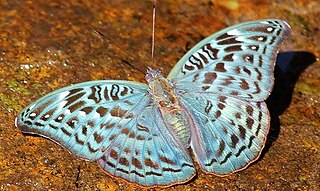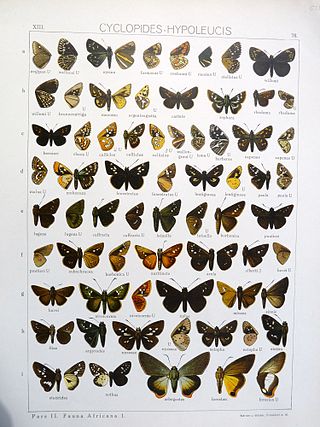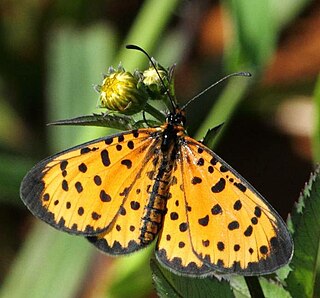Lepidochrysops lotana, the Lotana blue, is a species of butterfly in the family Lycaenidae. It is endemic to South Africa.

Euryphura achlys, the forest green butterfly or mottled-green nymph, is a butterfly of the family Nymphalidae. The southernmost limit is Ongoye Forest, South Africa. It is also found in the forests of eastern Zimbabwe, around Mulanje Massif in south eastern Malawi, Mozambique and Kenya.

Trida barberae, or Barber's ranger, is a species of butterfly in the family Hesperiidae. It is found in southern Africa, from the Cape Province to Zimbabwe, Lesotho, Transvaal, the Free State and KwaZulu-Natal.

Dingana is a butterfly genus from the subfamily Satyrinae in the family Nymphalidae.
Dingana dingana, or Dingaan's widow, is a butterfly of the family Nymphalidae. It is found in the KwaZulu-Natal midfields from the Drakensberg foothills to the Mooi River.
Dingana fraterna, the Stoffberg widow, is a butterfly of the family Nymphalidae. It is only known from one hillside to the south-west of the Stoffberg in the Mpumalanga province.
Dingana jerinae, or Jerine's widow, is a butterfly of the family Nymphalidae. It is only known from the upper southern scree slopes of the Kransberg in Limpopo, South Africa.
Dingana alticola, the red-banded widow, is a butterfly of the family Nymphalidae. It is only known from high altitude grassland in the Steenkampsberg area in the Mpumalanga province.

Dingana alaedeus, the Wakkerstroom widow, is a butterfly of the family Nymphalidae. It is only known from high altitude grassland at about 2,000 meters. It has a short flying period in summer. The specific name means “god of the wing” in Latin.
Dingana bowkeri, or Bowker's widow, is a butterfly of the family Nymphalidae. It is found in Lesotho, South Africa, in the Eastern Cape and Richmond and Cradock in the Cape Province.
Dingana clarki, or Clark's widow, is a butterfly of the family Nymphalidae. It is found in South Africa.
Dingana kammanassiensis, the Kammanassie widow, is a butterfly of the family Nymphalidae. It is only known from the slopes of the Kammanassie massif near Uniondale in South Africa.

Metisella aegipan, the mountain sylph or Shaka's ranger, is a butterfly of the family Hesperiidae. It is found in the mountains of the Cape in South Africa and in Mozambique, Zimbabwe and Lesotho. The habitat consists of wetlands, marshy places, and grassy gullies in montane grassland.

Gegenes niso, the common Hottentot skipper or plain Hottentot skipper, is a butterfly of the family Hesperiidae. It is found in Africa. It is found in a wide range of habitats, including savanna, grassland and open patches in forests.

Pardopsis is a monotypic butterfly genus in the family Nymphalidae.
Aloeides caffrariae, the border copper, is a butterfly of the family Lycaenidae. It is found in South Africa, where it is known from coastal grassland in the Eastern Cape.
Lepidochrysops ketsi, the ketsi blue, is a butterfly of the family Lycaenidae. It is found in South Africa.
Lepidochrysops tantalus, the king blue, is a butterfly of the family Lycaenidae found in South Africa.

Cupidopsis iobates, the tailed meadow blue, is a butterfly of the family Lycaenidae. It is found in most of Africa, south of the Sahara.






